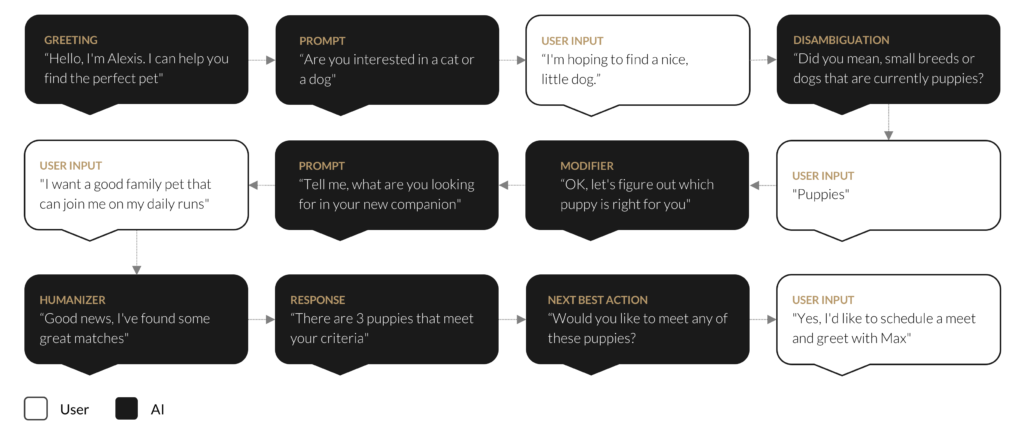Many of today’s digital experiences are powered by intelligent content management and marketing automation platforms that deliver personalized content to individuals based on their unique profile, behavior and interests. This is a huge leap forward from the traditional one size fits all approach, where everyone gets the same content no matter who or where they are. But what if content isn’t what you are looking for? What if you really want a conversation?
Content in The Real World
Picture this scenario. You visit a car dealer, hoping to learn about the latest model. You meet a friendly salesman and tell him that you want to know all about the car’s features and technology. And then… he hands you a brochure to read. While it may have all of the content that you need, it’s probably not the way you want to get the information. You’d probably prefer to have a conversation, where you could ask questions and get direct answers. At the same time, the salesman would also prefer to steer the conversation based on your questions and responses. This would allow him to get the most important information to you quickly and easily so that you don’t have to search for it.
This is the promise of conversational experiences. To get past the TL;DRs and enable an efficient exchange of information. For a car dealer, one-to-one conversations are feasible. They have a small set of customers that visit a showroom, which can typically be supported by individual sales team members. But what if you had to support thousands of conversations per hour? You would need an automated, scalable solution. You would need artificial intelligence.
Conversational AI
Often known as virtual agents, autonomous AI-driven programs have the power to deliver conversational experiences at scale. They can be trained to understand user intent and provide dynamic responses in a conversational manner. However, the real challenge is doing it convincingly, so that the user feels like they are in a conversation.
The word “conversation” originates from two latin words “con” (with) and “versare” (to turn about). It is a two-way dialog in which information is exchanged in an alternating fashion. There should be a natural ebb and flow as each party takes turns communicating and listening. So, if a virtual agent isn’t asking you questions, and gathering information, then it isn’t really having a conversation.
Anatomy of a Conversation
In order to create truly conversation experiences you need a powerful platform that is capable of cognitive processes and machine learning. But you also need to teach it how to have a conversation. In order to achieve this, Perficient has developed a conversational framework that breaks down dialog into individual elements that can be stitched together to form a conversation. Described below are the core elements of the framework.
Greeting – A phrase that is used to initiate a conversation. This typically includes an introduction and context of the AI’s capabilities. “Hello, I’m Alexis. I can help you find the perfect pet”
Prompt – Phrases that elicit user input. Prompts are used as part of the information gathering process. “Are you interested in a dog or a cat?”
Disambiguation – Terminology that is used to clarify/confirm a user’s intent within a conversation. This is typically used to ensure the system understands the request and responds with the appropriate information. “Did you mean, small breed dogs or dogs that are currently puppies?”
Modifier – Transitional phrases that acknowledge the user’s input and prepares them for the next step. “Ok, let’s figure out which puppy is right for you.”
Humanizer – Supplemental phrases that reinforce the intended tone and voice of the AI persona. “Good news, I’ve found some great matches”
Response – Content delivered by the AI that supports the user’s intent. This is the information sharing part of the conversation. The conversation element may be supported by additional content or results of the query. “There are 3 puppies near you that meet your criteria!”
Next Best Action – A recommended action a user can take as their next step in the journey. This can either extend the conversation or help users complete a task. “Would you like to meet any of these puppies?”
Error Handling – Syntax used to indicate that an error has occurred. This is an essential part of communicating limitations and/or failing gracefully. “I’m sorry, I don’t have access to that information”
Transition – Messaging that supports the transition to a human. A smooth transition is essential to any AI solution. “I need to connect you to a live agent to help with that. I’ll let them know where we left off, so you can pick it up from there”
Sample Conversation

A conversational framework is a great starting point for crafting conversational experiences. It identifies the various conversational elements and how they interact with each other. But in order to effectively communicate to your audience, you must also clearly define the tone and voice of your solution. Is it going to be formal or informal? Will it be loquacious or matter-of-fact? Defining these attributes will help you stay true to your brand and better support the needs of your target audience.
Better Conversations, Better Experiences
As digital content is continuously published and individuals are overloaded with information, it becomes increasingly important to find ways to simplify interactions. Conversational interfaces have the ability to bring information directly to the user, which saves time and reduces the user’s cognitive load. This ultimately leads to better customer experiences. After all, as Kramer once proved in an episode of Seinfeld, being able to simply tell a system what you’re looking for is a lot easier than hunting and pecking. That is why conversation is destined to be the next step in the evolution of content.
Looking to get started on your conversational AI journey? Discover how with CX AI℠ .

great read!